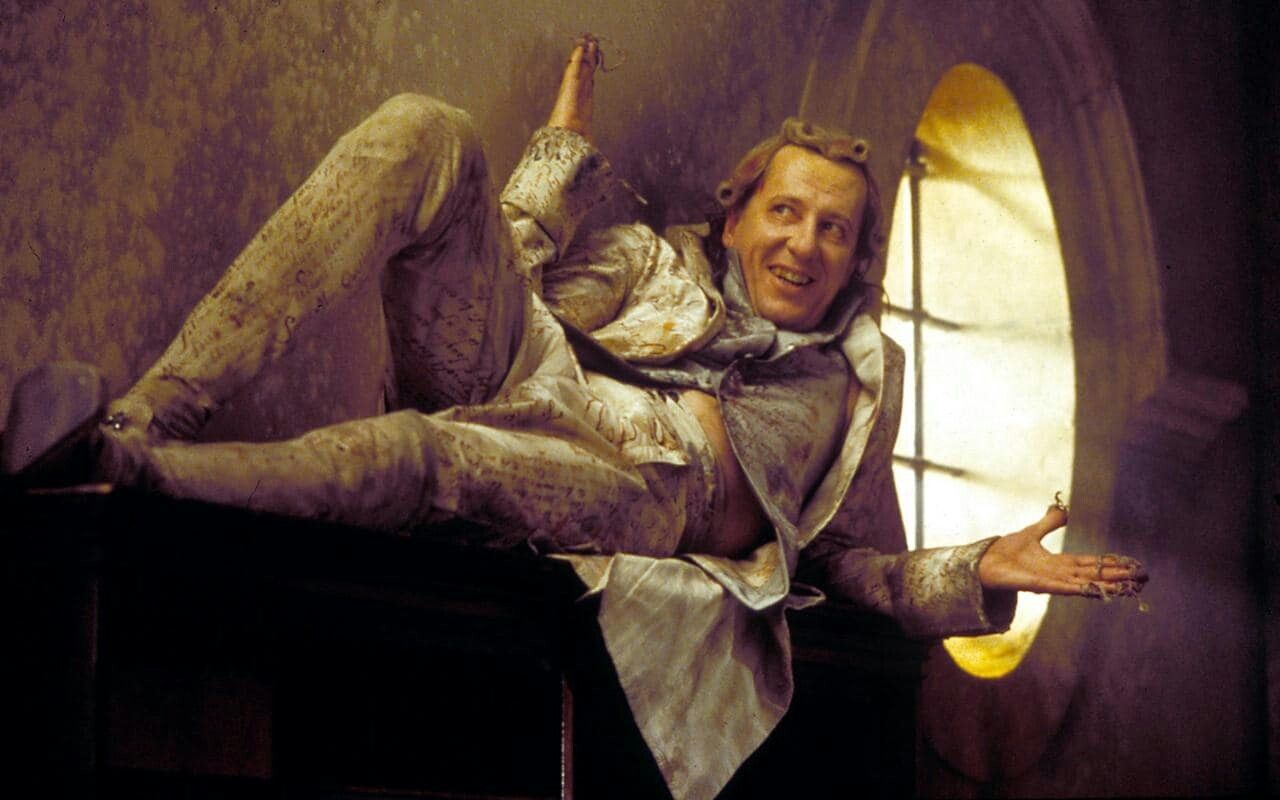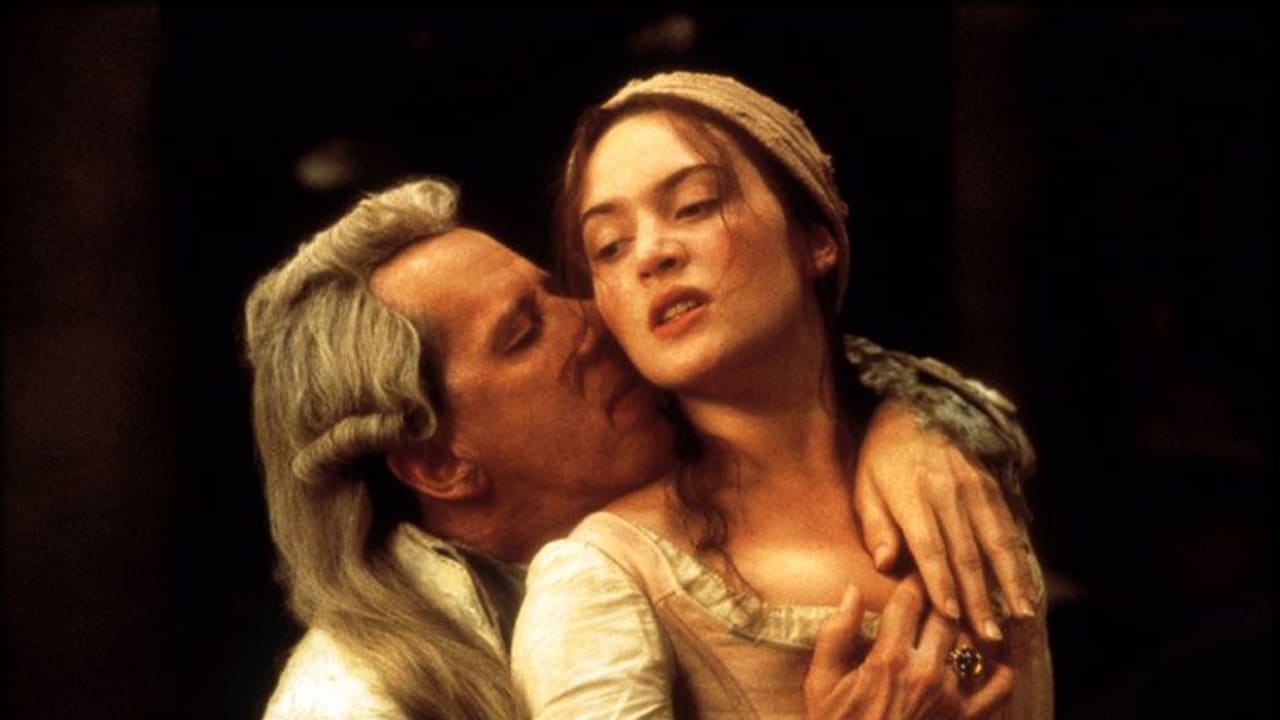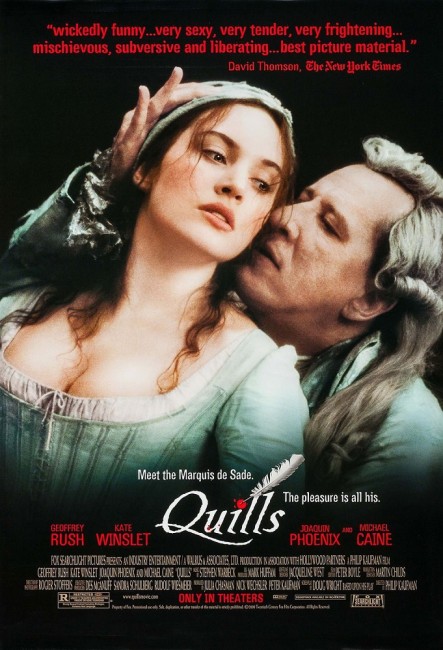Crew
Director – Philip Kaufman, Screenplay/Based on the Play by Doug Wright, Producers – Julia Chasman, Peter Kaufman & Nick Weschler, Photography – Rogier Stoffers, Music – Stephen Warbeck, Special Effects Supervisor – Stuart Brisden, Prosthetic Effects – Conor O’Sullivan, Production Design – Martin Childs. Production Company – Fox Searchlight/Walrus and Associates.
Cast
Geoffrey Rush (The Marques de Sade), Joqauin Phoenix (Abbe Coulmier), Michael Caine (Dr Royer-Collard), Kate Winslet (Madeline Le Clerc), Amelia Warner (Simone), Stephen Moyer (Prouix), Elizabeth Berrington (Charlotte), Billie Whitelaw (Madame Le Clerc), Stephen Marcus (Bouchon), Patrick Malahide (Delbene)
Plot
In the early 19th Century, the Marquis de Sade, imprisoned in the Charenton asylum, writes works of pornography and depravity, using the laundry maid Madeline Le Clerc to smuggle them out to a publisher. These become a cause celebre and come to the attention of Napoleon who dispatches the alienist Dr Royer-Collard to Charenton to help its director, the liberal cleric Abbe Coulmier, silence de Sade. The impudent de Sade continues, writing a play performed by the inmates that mocks Royer-Collard’s marriage to a young virgin nun. Royer-Collard retaliates by confiscating de Sade’s quills and paper. However, de Sade persists, using everything from chicken bones and broken glass as a pen and his bedsheets and clothing as paper.
Quills is not a genre work per se, but it is included here for the reasons that works like Gothic (1986), Ed Wood (1994) and Gods and Monsters (1998) are – it concerns the creative processes of an individual – in this case the Marquis de Sade – whose work was genre material. De Sade’s works have been adapted to the screen a number of times and fall well within genre confines. Equally so de Sade has turned up as a character in numerous films, ranging from the reasonably historically balanced – The Persecution and Assassination of Jean-Paul Marat as Performed by the Inmates of the Asylum of Charenton Under the Direction of the Marquis de Sade (1966), De Sade (1969) and Marquis de Sade (1996) – to the outrightly silly – X Marquis the Spot, an episode of Jack of All Trades where de Sade was a campy refugee from a Rocky Horror Show (1975) party running a South Seas BDSM brothel.
Quills is made by Philip Kaufman, a director who has developed from a strong and intelligent commercial dramatist – the likes of Invasion of the Body Snatchers (1978), The Right Stuff (1983) and Rising Sun (1993), with the sole exception of the disappointing serial killer thriller Twisted (2004) – to in the last couple of decades becoming what might be described as a combination of Merchant Ivory and Zalman King, with works of literary erotica like the Milan Kundera adaptation The Unbearable Lightness of Being (1987); the underrated Henry and June (1990) from the diaries of Anais Nin; this adapted by Doug Wright from his 1995 off-Broadway play; as well as having promised biopics of Liberace and Ernest Hemingway for a number of years. Unbearable Lightness, Henry and June and Quills form a thematic trilogy of sorts, featuring individuals whose explorations of sexuality challenge and redefine traditional models.
What is noticeable about Quills is the incredibly sympathetic portrait of the Marquis de Sade it offers. De Sade is a figure whose notoriety became mythical within his lifetime and even more so since. Indeed, his name has come to stand in for cruelty – ‘sadism’ ie. sade-ism. The actual crimes he was convicted for – threatening a prostitute with flagellation (1763), beating a neighbouring woman (1768) and supposedly poisoning two women with non-lethal aphrodisiacs during an orgy (1772) – would only be regarded as misdemeanour charges today. In fact, the real charges that had de Sade imprisoned as Charenton were more political than they were anything to do with infamy – his first imprisonment (1777-90) was due to his influential mother-in-law’s outrage at his elopement with her daughter and having obtained a lettre du cachet from the king that allowed his imprisonment without trial; his second confinement in 1801-14 (the period during which the film would appear to take place) was solely on the suspicion of his having authored a pamphlet lampooning Napoleon and Josephine. However, it is the notoriety of de Sade’s works, which set out to catalogue all human sexual proclivities and perversions, that made his name what it is today. (It is the measure of de Sade’s notoriety that most of his works remained banned in the US until the 1990s).

Most films about the Marquis de Sade have tended to take his reputation as gospel – the likes of Night Terrors (1993) where he was portrayed as an inhuman sadistic monster or The Skull (1965) where his skull is considered so steeped in depravity it is able to exude physical evil in the present day, even DC Comics who have named an intergalactic super-villain (Desaad) after him. (The sole exception to this is the bizarre Belgian puppet film Marquis (1989), which has many similarities to Quills, and portrayed de Sade as a gentle man at war with his talking penis).
Quills perhaps comes the closest to understanding de Sade in accurately seeing his work as having a dual nature – first as a vehicle for its imprisoned author’s private titillations and secondly as a scabrous attack on public hypocrisy. (De Sade saw his work as only documenting a certain base truth about human nature and considered that it was laughable for a society to condemn his work while celebrating public guillotinings and the bloodthirsty spectacles of The Reign of Terror following the French Revolution).
Quills falls in love with its idea of de Sade as a gleefully filthy pornographer and iconoclastic mudslinger so much so that it bowdlerizes him in the opposite direction of these other films that portray him as evil incarnate. De Sade here is such a lovably obscene leprechaun in Geoffrey Rush’s OTT performance that it is hard to see him as also the sadist he was. In fact, Quills‘s portrait of de Sade is not so much one of he as a pornographer and sadist so much as it is something akin to The People vs Larry Flynt (1996) – a film that used a somewhat reprehensible figure to conduct a debate about free speech and censorship. The script even contrives a dramatic situation to address the current debate offered in favour of media censorship – whether violent and sexually inflammatory works should be censored so as not to influence susceptible minds – in a scene where de Sade’s work inflame the inmates to arson and murder.

Here the film is so much enamoured of its protagonist than that any opposing argument in favour of censorship gets no voice. The film sets up Michael Caine (who is miscast and just does the old Michael Caine thing of bawling dialogue in uppercase to make a dramatic point – what the role needed was someone who could suggest pernicious, tightly imprisoned hypocrisy) as his opponent, but there is no big playoff between the two characters. Rather the film ends on de Sade’s death and a series of ironic reversals that make for a good if somewhat far-fetched dramatic sting (and completely invented history).
Quills is certainly a well written film. The characters and their juxtapositions are well etched, although both Kate Winslet’s chambermaid and especially Amelia Warner as Michael Caine’s nun-become-wife, who sexually blossoms upon reading de Sade’s work and flees with the architect, are far too much modern women to seem credible for the period. The film is best during its depiction of the irrepressibility of the creative urge, at getting inside de Sade’s need to write, using everything from wine, blood and excrement on bedsheets, clothing and walls, and chicken bones and broken glass as quills, even dictating his stories from cell to cell between asylum inmates in an elaborate game of Chinese Whispers. It is here, at least, one can understand completely where the character is coming from.
(Nominee for Best Actor (Geoffrey Rush) and Best Adapted Screenplay at this site’s Best of 2000 Awards).


